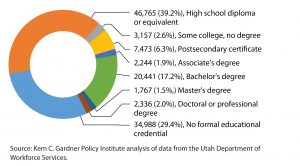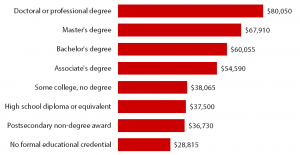Blog Post
Insight: The Supply of and Demand for Skills in Utah
By: John Downen
Note: The opinions expressed are those of the author alone and do not reflect an institutional position of the Gardner Institute. We hope the opinions shared contribute to the marketplace of ideas and help people as they formulate their own INFORMED DECISIONS™.
Dec 4, 2019 – There’s been a lot of talk lately about labor shortages. After 10 years of recovery, firms are having difficulty filling jobs. Private-sector employment in Utah has grown 3.5% annually since 2010. Unemployment rates are at historic lows: 2.5% in October. However, wage growth has been sluggish at best, averaging just 1.1 percentage points above inflation annually since 2010. A tight labor market should lead to faster wage growth as employers compete for a limited supply.
The Gardner Institute recently completed a study comparing the supply of new entrants to Utah’s labor force with the projected demand for occupations over the next several years.
The Utah Department of Workforce Services projects that nearly 70% of annual job openings between now and 2026 will be for occupations typically requiring at most a high school diploma; 20% of openings will typically require a bachelor’s degree or higher (see Figure 1).
Figure 1: Annual Labor Demand by Typical Minimum Education Level, 2016–2026

Utah is producing a skilled workforce. Almost three-quarters, 73%, of “homegrown” new labor force entrants have a postsecondary certificate or higher degree; more than half have a bachelor’s degree or higher. These individuals are responding to the wage premium provided by additional education. The median wage for a position typically requiring at least an associate’s degree is 45% higher than that for a position requiring a high school diploma. This premium grows with increasing education. Jobs typically requiring a bachelor’s degree average 60% higher wages than for a position requiring a high school diploma; master’s degree jobs pay 80% more; and Ph.D. positions pay more than double (see Figure 2).
Figure 2: Median Wage in Utah by Typical Minimum Education Level, 2017

Source: Kem C. Gardner Policy Institute analysis of data from the Utah Department of Workforce Services.
After matching graduates, dropouts, and net in-migrants to projected openings, we found an expected labor shortage in Utah, with roughly two out of five jobs lacking a suitable supply. However, 90 percent of this unfilled demand is for occupations requiring at most a high school diploma. Skilled occupations, those requiring at least a certificate, account for just 9% of the unmet demand.
The largest skilled shortages are for truck drivers; technical and scientific product sales representatives; heating, air conditioning, and refrigeration mechanics and installers; telecommunications equipment installers and repairers; and securities, commodities, and financial services sales agents.
Many new graduates may have difficulty finding jobs for which they are well prepared. Our analysis matched graduates to job openings for which their degrees directly prepared them. This left a large surplus of unmatched supply, so we relaxed our criteria and allowed overqualified graduates to take jobs that required a lower level of education than they had obtained. We also assigned some of our unmatched supply to occupations for which they were not directly prepared, but which were in the same group of occupations. Nonetheless, we were unable to match more than one-third of postsecondary graduates to suitable jobs.
Our analysis used the Utah Department of Workforce Services’ occupational employment projections. Individual occupations have an associated “typical” entry-level education requirement. We assigned postsecondary graduates or “completers” to job openings based on a crosswalk linking higher education degree fields to occupations for which those majors “directly prepare” individuals. We incorporated some flexibility to permit matches of “overqualified” graduates to jobs, and graduates who were not “directly prepared” for particular occupations. Nonetheless, our analysis does not capture the full dynamism of labor markets and the often unusual employment trajectories that individuals follow.
John Downen is deputy director of economic and public policy research at the Kem C. Gardner Policy Institute.






